A Simple Empirical Band-Ratio Algorithm to Assess Suspended Particulate Matter from Remote Sensing over Coastal and Inland Waters of Vietnam: Application to the VNREDSat-1/NAOMI Sensor
Abstract
1. Introduction
2. Material and Methods
2.1. In Situ Data Sets
2.2. Satellite Match-Up Data Set
2.3. Evaluated Historical SPM Inversion Algorithms
2.4. Statistical Indicators
3. Results and Discussion
3.1. Development of a SPM Inversion Algorithm for VNREDSat-1/NAOMI
3.2. Inter-Comparison and Validation of SPM Inversion Algorithms for Medium Spatial Sensors over Vietnamese Coastal Waters
3.3. Validation of the Red-NIR/V1SPM Algorithms Using OLI Observations
3.4. Illustration of the Monitoring of a Flooding Event from VNREDSat-1
4. Concluding Remarks
Author Contributions
Funding
Acknowledgments
Conflicts of Interest
References
- Pruszak, Z.; Szmytkiewicz, M.; Hung, N.M.; Ninh, P.V. Coastal processes in the Red river delta area, Vietnam. Coast. Eng. J. 2002, 44, 97–126. [Google Scholar] [CrossRef]
- Boateng, I. GIS assessment of coastal vulnerability to climate change and coastal adaption planning in Vietnam. J. Coast. Conserv. 2012, 16, 25–36. [Google Scholar] [CrossRef]
- Dastgheib, A.; Reyns, J.; Thammasittirong, S.; Weesakul, S.; Thatcher, M.; Ranasinghe, R. Variations in the Wave Climate and Sediment Transport Due to Climate Change along the Coast of Vietnam. J. Mar. Sci. Eng. 2016, 4, 86. [Google Scholar] [CrossRef]
- Du, H.T.; Kunzmann, A. The Sediment Load and Deposition by River Discharge and Their Relation to Organochlorine Pesticides Pollutants in the Sediment Bottom of Nha Trang Bay, Vietnam. Ocean Sci. J. 2015, 50, 455–466. [Google Scholar] [CrossRef]
- Vinh, V.D.; Ouillon, S.; Thanh, T.D.; Chu, L.V. Impact of the Hoa Binh dam (Vietnam) on water and sediment budgets in the Red River basin and delta. Hydrol. Earth Syst. Sci. 2014, 18, 3987–4005. [Google Scholar] [CrossRef]
- Loisel, H.; Mangin, A.; Vantrepotte, V.; Dessailly, D.; Ngoc, D.D.; Garnesson, P.; Ouillon, S.; Lefebvre, J.P.; Mériaux, X.; Phan, T.M. Variability of suspended particulate matter concentration in coastal waters under the Mekong’s influence from ocean color (MERIS) remote sensing over the last decade. Remote Sens. Environ. 2014, 150, 218–230. [Google Scholar] [CrossRef]
- Anthony, E.J.; Brunier, G.; Besset, M.; Goichot, M.; Dussouillez, P.; Nguyen, V.L. Linking rapid erosion of the Mekong River delta to human activities. Sci. Rep. 2015. [Google Scholar] [CrossRef]
- Hauser, L.T.; Vu, G.N.; Nguyen, B.A.; Dade, E.; Nguyen, H.M.; Nguyen, T.T.Q.; Le, Q.T.; Vu, L.H.; Tong, A.T.H.T.; Pham, H.V. Uncovering the spatio-temporal dynamics of land cover change and fragmentation of mangroves in the Ca Mau peninsula, Vietnam using multi-temporal SPOT satellite imagery (2004–2013). Appl. Geogr. 2017, 86, 197–207. [Google Scholar] [CrossRef]
- Loisel, H.; Vantrepotte, V.; Ouillon, S.; Ngoc, D.D.; Herrmanm, M.; Tran, V.; Meriaux, X.; Dessailly, D.; Jamet, C.; Duhaut, T.; et al. Assessment and analysis of the chlorophyll-a concentration variability over the Vietnamese coastal waters from the MERIS ocean color sensor (2002–2012). Remote Sens. Environ. 2017, 190, 217–232. [Google Scholar] [CrossRef]
- Marchesiello, P.; Nguyen, M.; Gratiot, N.; Loisel, H.; Anthony, E.; Dinh, S.; Almar, R.; Kestenare, E. Erosion of the coastal Mekong delta: Assessing natural against man induced processes. Cont. Shelf Res. 2019, 181, 72–89. [Google Scholar] [CrossRef]
- Tajima, Y.; Gunasekara, K.; Nguyen, H.T. Satellite-based monitoring of contrasting characteristics of suspended sediment discharged from the Red and the Ma river systems along the northern coast of Vietnam. Int. J. Sediment Res. 2018. [Google Scholar] [CrossRef]
- Sathyendranath, S. Remote Sensing of Ocean Colour in Coastal, and Other Optically-Complex, Waters. In IOCCG Report Number 3; IOCCG: Dartmouth, NS, Canada, 2000; ISBN 978-1-896246-54-3. ISSN 1098-6030. [Google Scholar]
- Loisel, H.; Vantrepotte, V.; Jamet, C.; Ngoc, D.D. Challenges and New Advances in Ocean Color Remote Sensing of Coastal Waters. Top. Oceanogr. 2013. [Google Scholar] [CrossRef]
- Tassan, S. Local algorithms using SeaWiFS data for the retrieval of phytoplankton, pigments, suspended sediment, and yellow substance in coastal waters. Appl. Opt. 1994, 33, 2369–2378. [Google Scholar] [CrossRef] [PubMed]
- Forget, P.; Ouillon, S. Surface suspended matter off the Rhone river mouth from visible satellite imagery. Oceanol. Acta 1998, 21, 739–749. [Google Scholar] [CrossRef]
- Siswanto, E.; Tang, J.; Yamaguchi, H.; Ahn, Y.H.; Ishizaka, J.; Yoo, S.; Kim, S.W.; Kiyomoto, Y.; Yamada, K.; Chiang, C.; et al. Empirical ocean-color algorithms to retrieve chlorophyll-a, total suspended matter, and colored dissolved organic matter absorption coefficient in the Yellow and East China Seas. J. Oceanogr. 2011. [Google Scholar] [CrossRef]
- Doxaran, D.; Froidefond, J.M.; Lavender, S.; Castaing, P. Spectral signature of highly turbid waters Application with SPOT data to quantify suspended particulate matter concentrations. Remote Sens. Environ. 2002, 81, 149–161. [Google Scholar] [CrossRef]
- Yepez, S.; Laraque, A.; Martinez, J.-M.; Sa, J.D.; Carrera, J.M.; Castellanos, B.; Gallay, M.; Lopez, J.L. Retrieval of suspended sediment concentrations using Landsat-8 OLI satellite images in the Orinoco River (Venezuela). Comptes Rendus Geosci. 2018, 350, 20–30. [Google Scholar] [CrossRef]
- Nechad, B.; Ruddick, K.G.; Park, Y. Calibration and validation of a generic multisensor algorithm for mapping of total suspended matter in turbid waters. Remote Sens. Environ. 2010, 114, 854–866. [Google Scholar] [CrossRef]
- Han, B.; Loisel, H.; Vantrepotte, V.; Mériaux, X.; Bryère, P.; Ouillon, S.; Dessailly, D.; Xing, Q.; Zhu, J. Development of a Semi-Analytical Algorithm for the Retrieval of Suspended Particulate Matter from Remote Sensing over Clear to Very Turbid Waters. Remote Sens. 2016, 8, 211. [Google Scholar] [CrossRef]
- Balasubramanian, S.V.; Pahlevan, N.; Smith, B.; Binding, C.E.; Schalles, J.; Loisel, H.; Gurlin, D.; Greb, S.; Alikas, K.; Uusõue, M.; et al. Robust algorithm for estimating total suspended solids (TSS) in inland and nearshore coastal waters. Remote Sens. Environ. 2020, 246, 111768. [Google Scholar] [CrossRef]
- Minh, C.D. Space Technology Development of Vietnam in 2011–2012. In Proceedings of the APRSAF-19, Kuala Lumpur, Malaysia, 11–14 December 2012. [Google Scholar]
- Luquet, P.; Chikouche, A.; Benbouzid, A.B.; Arnoux, J.J.; Chinal, E.; Massol, C.; Rouchit, P.; Zotti, S.D. NAOMI instrument: A product line of compact & versatile cameras designed for high resolution missions in Earth observation. In Proceedings of the International Conference on Space Optics—ICSO 2008, Toulouse, France, 21 November 2017; p. 45. [Google Scholar]
- Ngoc, D.D.; Loisel, H.; Duforêt-Gaurier, L.; Jamet, C.; Vantrepotte, V.; Goyens, C.; Xuan, H.C.; Minh, N.N.; Van, T.N. Atmospheric correction algorithm over coastal and inland waters based on the red and NIR bands: Application to Landsat-8/OLI and VNREDSat-1/NAOMI observations. Opt. Express 2019, 27, 31676–31697. [Google Scholar] [CrossRef] [PubMed]
- Vanhellemont, Q. Adaptation of the dark spectrum fitting atmospheric correction for aquatic applications of the Landsat and Sentinel-2 archives. Remote Sens. Environ. 2019, 225, 175–192. [Google Scholar] [CrossRef]
- Röttgers, R.; Heymann, K.; Krasemann, H. Suspended matter concentrations in coastal waters: Methodological improvements to quantify individual measurement uncertainty. Estuar. Coast. Shelf Sci. 2014, 151, 148–l55. [Google Scholar] [CrossRef]
- Stavn, R.H.; Rick, H.J.; Falster, A.V. Correcting the errors from variable sea salt retention and water of hydration in loss on ignition analysis: Implications for studies of estuarine and coastal waters. Estuar. Coast. Shelf Sci. 2009, 81, 575–582. [Google Scholar] [CrossRef]
- Ngoc, D.D.; Loisel, H.; Jamet, C.; Vantrepotte, V.; Duforêt-Gaurier, L.; Minh, C.D.; Mangin, A. Coastal and inland water pixels extraction algorithm (WiPE) from spectral shape analysis and HSV transformation applied to Landsat 8 OLI and Sentinel-2 MSI. Remote Sens. Environ. 2019, 223, 208–228. [Google Scholar] [CrossRef]
- Doxaran, D.; Cherukuru, N.C.; Lavender, S.J. Use of reflectance band ratios to estimate suspended and dissolved matter concentrations in estuarine waters. Int. J. Remote Sens. 2005, 26, 1763–1769. [Google Scholar] [CrossRef]
- Vanhellemont, Q.; Ruddick, K. Turbid wakes associated with offshore wind turbines observed with Landsat 8. Remote Sens. Environ. 2014, 145, 105–115. [Google Scholar] [CrossRef]
- Vanhellemont, Q.; Ruddick, K. Advantages of high quality SWIR bands for ocean colour processing: Examples from Landsat-8. Remote Sens. Environ. 2015, 161, 89–106. [Google Scholar] [CrossRef]
- Morel, A.; Gentili, B. Diffuse reflectance of oceanic waters. II. Bidirectional aspects. Appl. Opt. 1993, 32, 6864–6872. [Google Scholar] [CrossRef]
- Morel, A.; Gentili, B. Diffuse reflectance of oceanic waters. III. Implication of bidirectionality for the remote-sensing problem. Appl. Opt. 1996, 35, 4850–4862. [Google Scholar] [CrossRef]
- Loisel, H.; Morel, A. Non-isotropy of the upward radiance field in typical coastal (Case 2) waters. Int. J. Remote Sens. 2001, 22, 275–295. [Google Scholar] [CrossRef]
- Doxaran, D.; Froidefond, J.M.; Castaing, P. A refectance band ratio used to estimate suspended matter concentrations in sediment-dominated coastal waters. Int. J. Remote Sens. 2002, 23, 5079–5085. [Google Scholar] [CrossRef]
- Loisel, H.; Lubac, B.; Dessailly, D.; Duforet-Gaurier, L.; Vantrepotte, V. Effect of inherent optical properties variability on the chlorophyll retrieval from ocean color remote sensing: An in situ approach. Opt. Express 2010, 18, 20949–20959. [Google Scholar] [CrossRef] [PubMed]
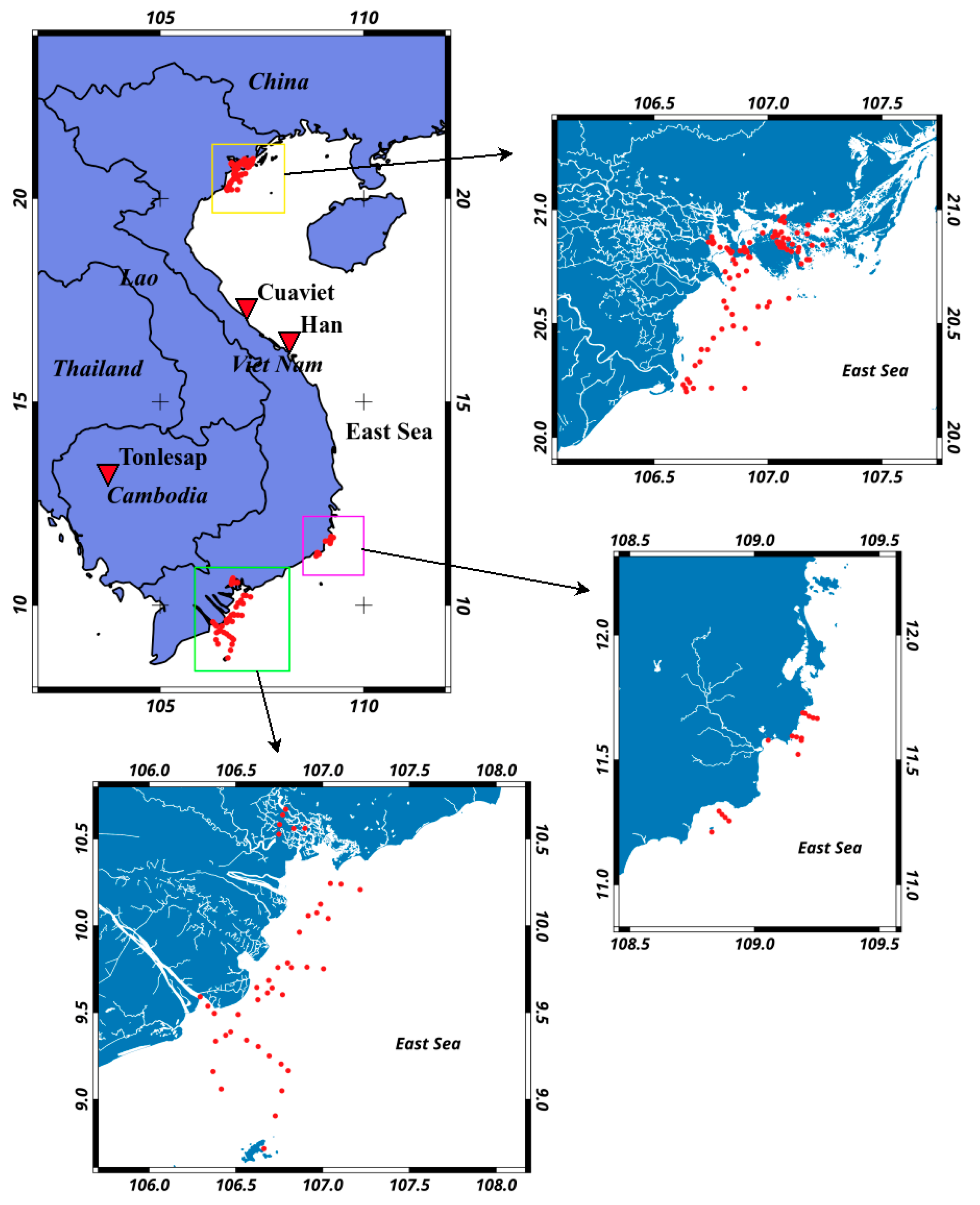
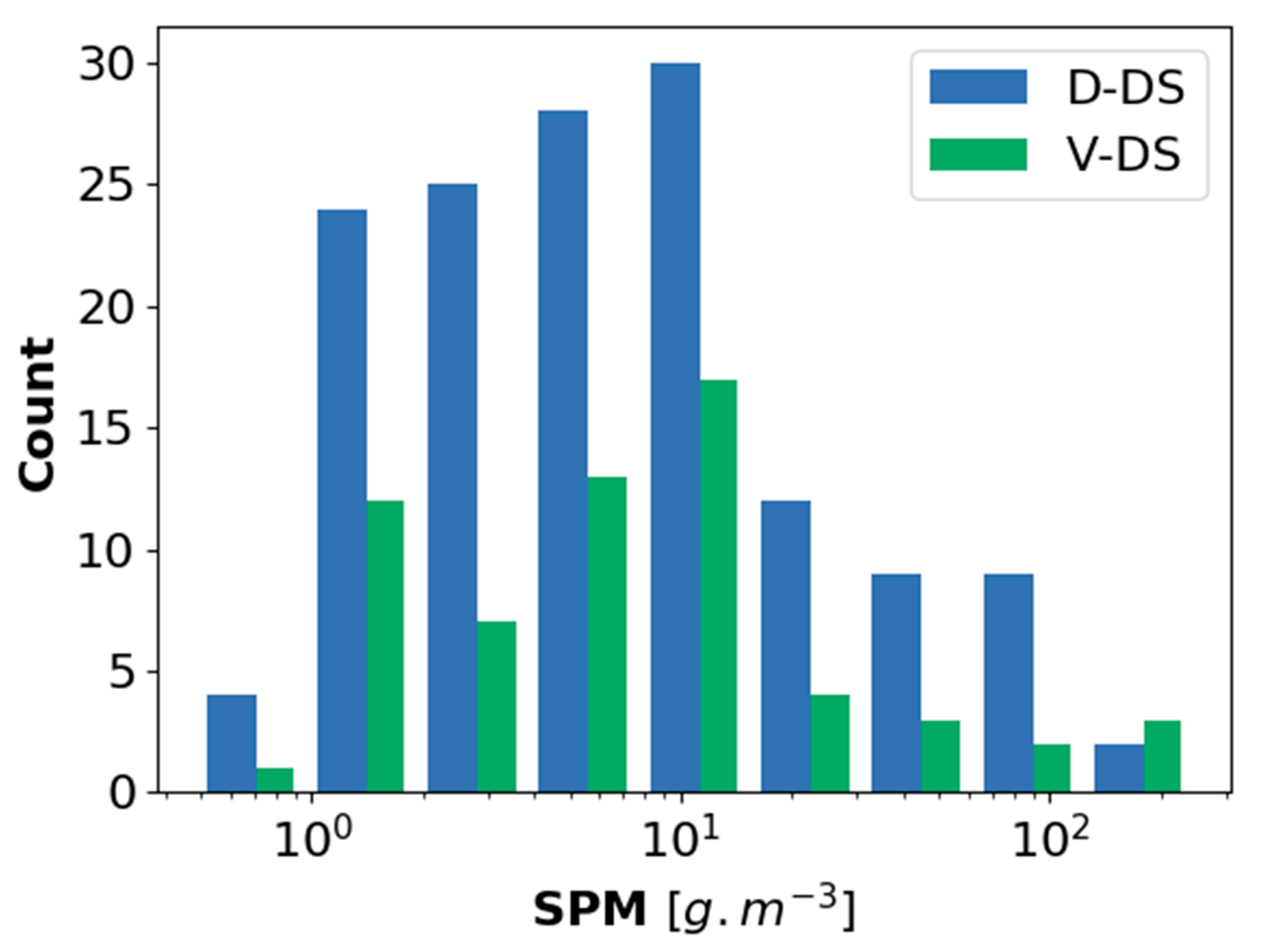
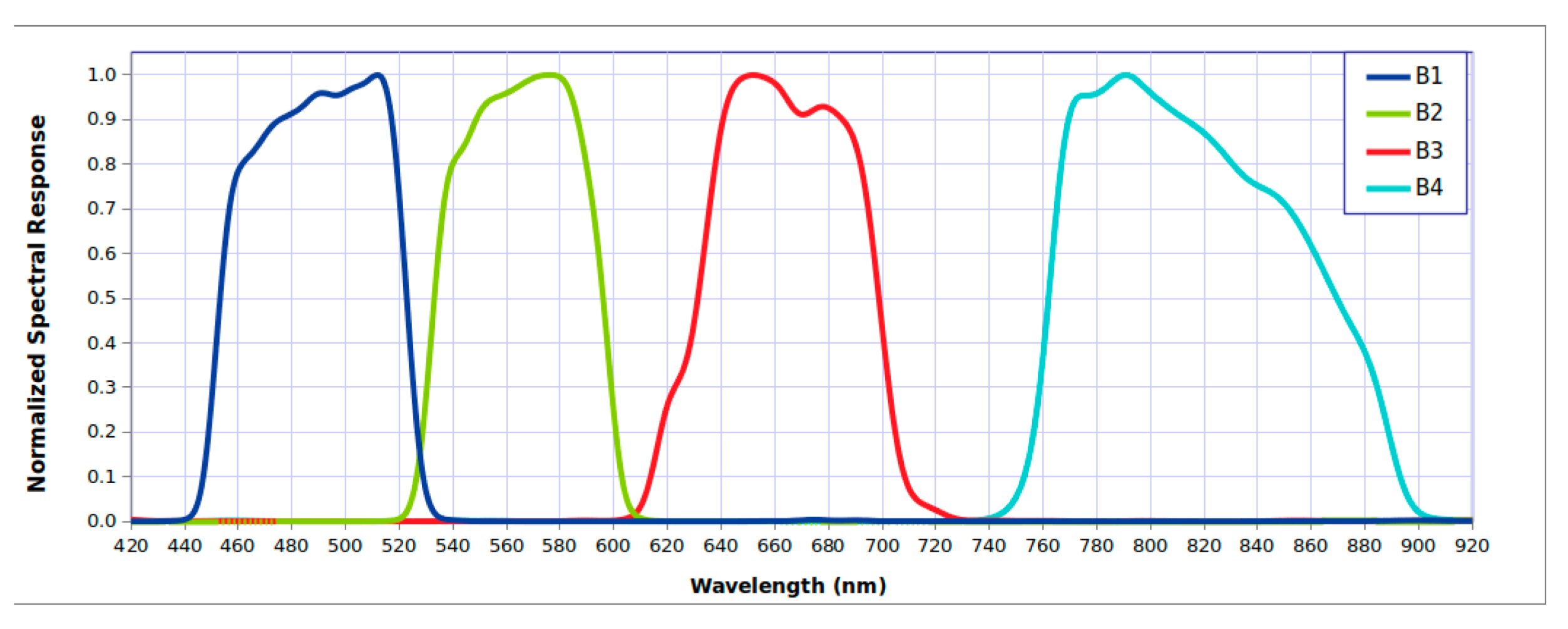
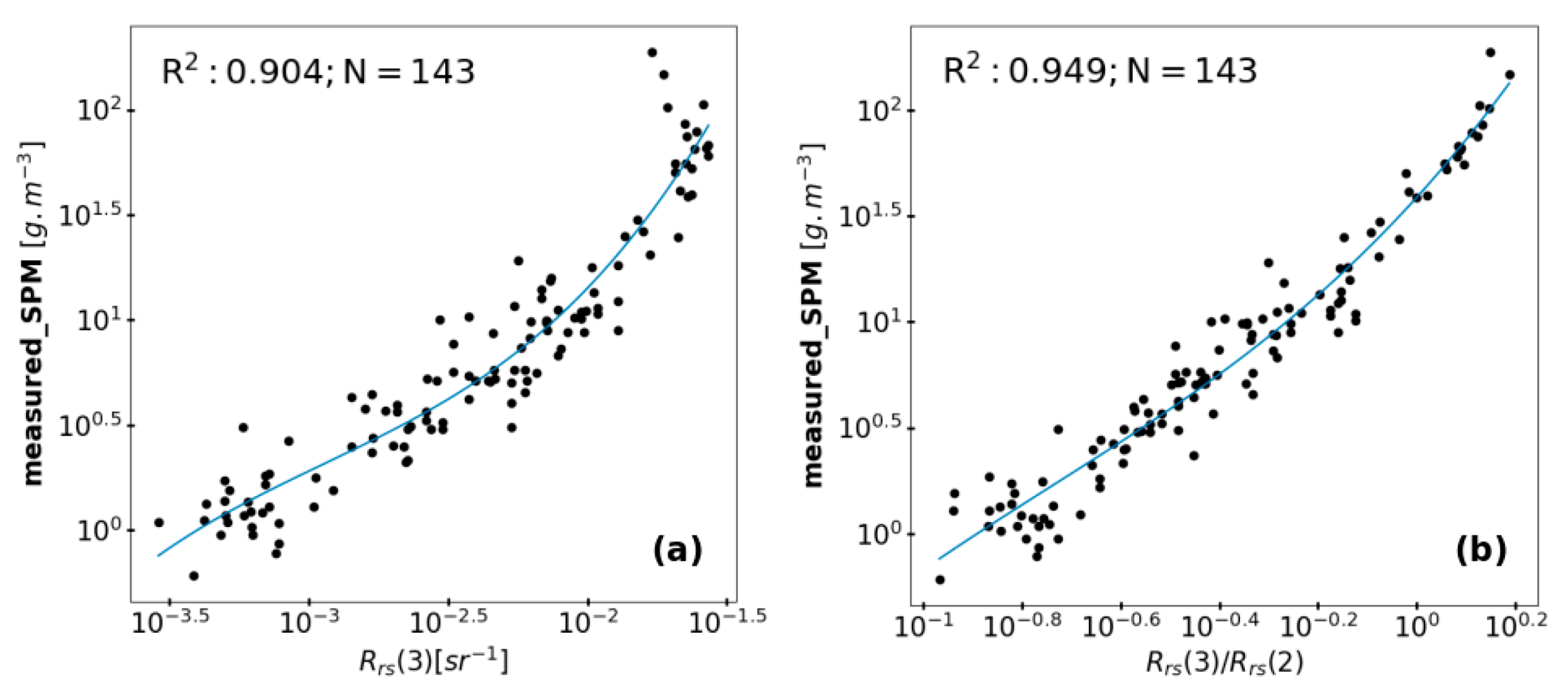
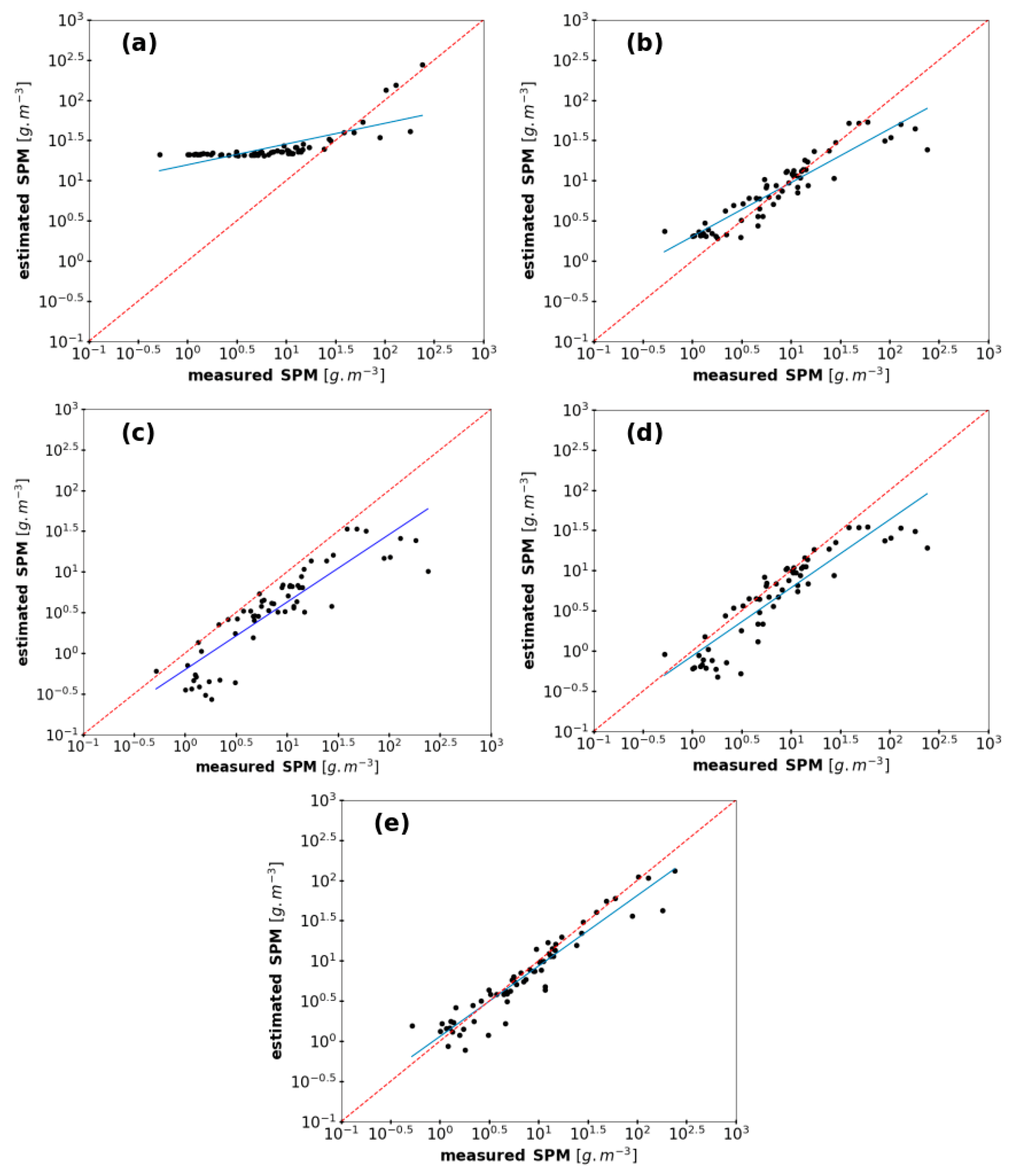

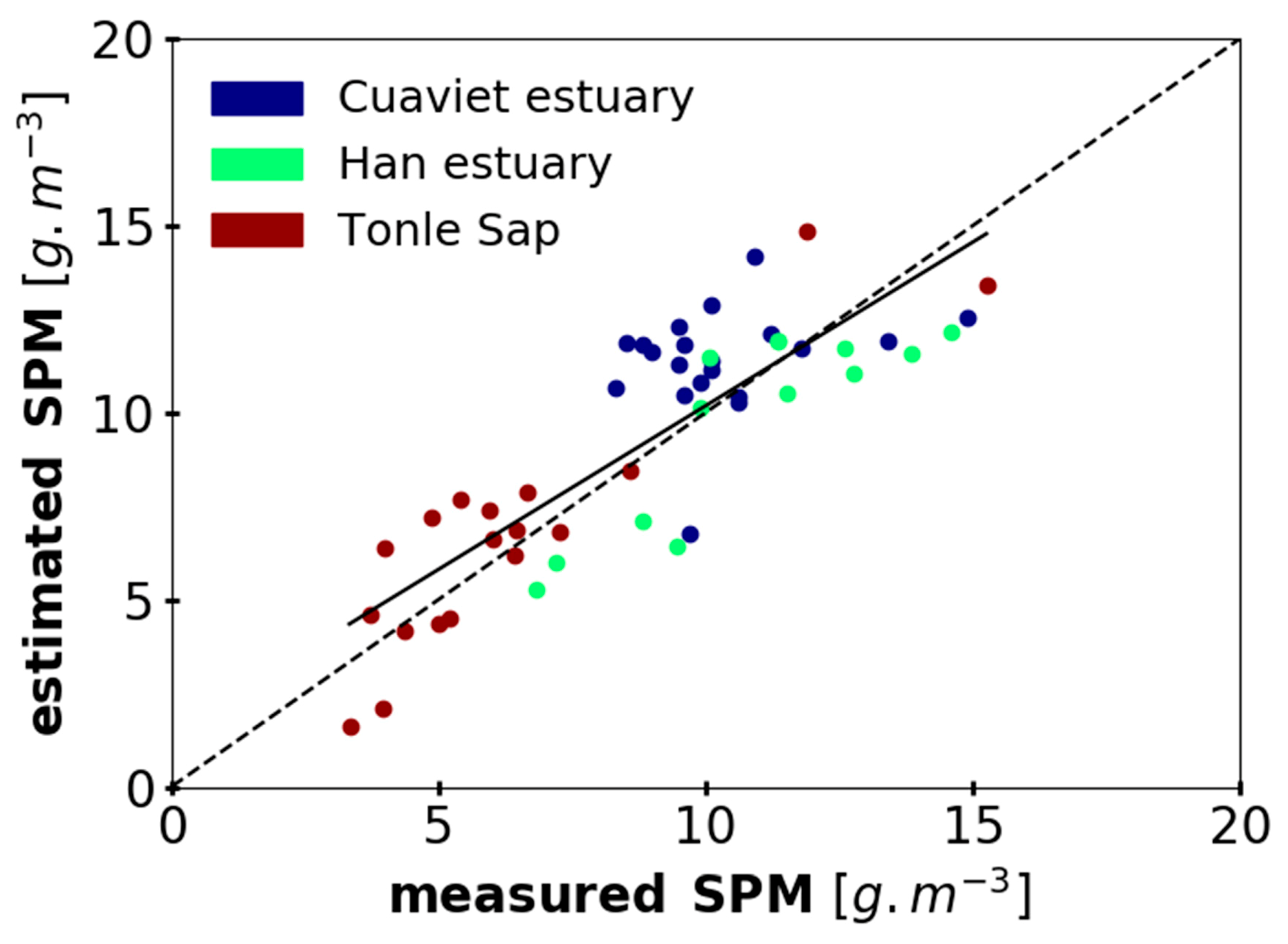
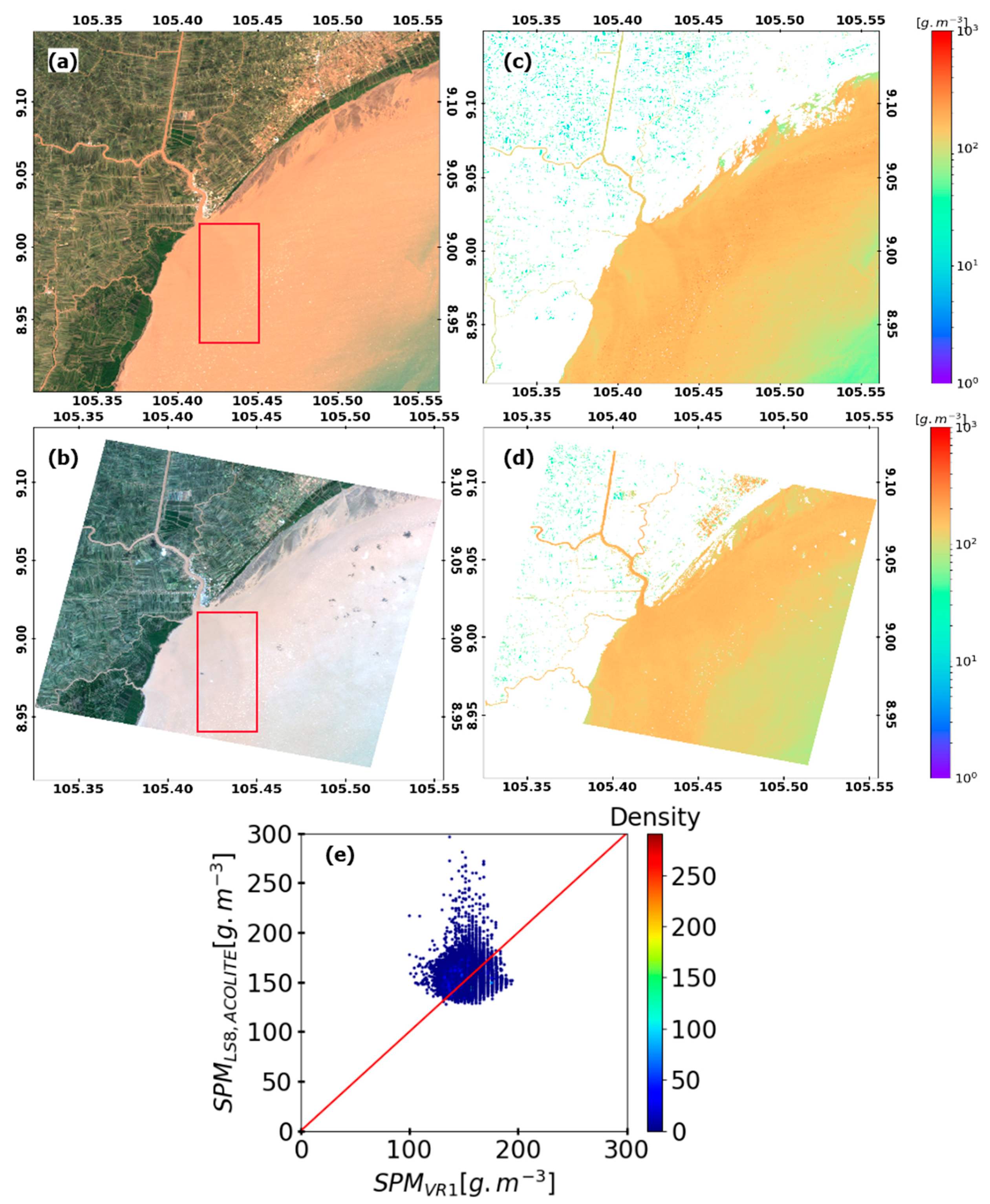
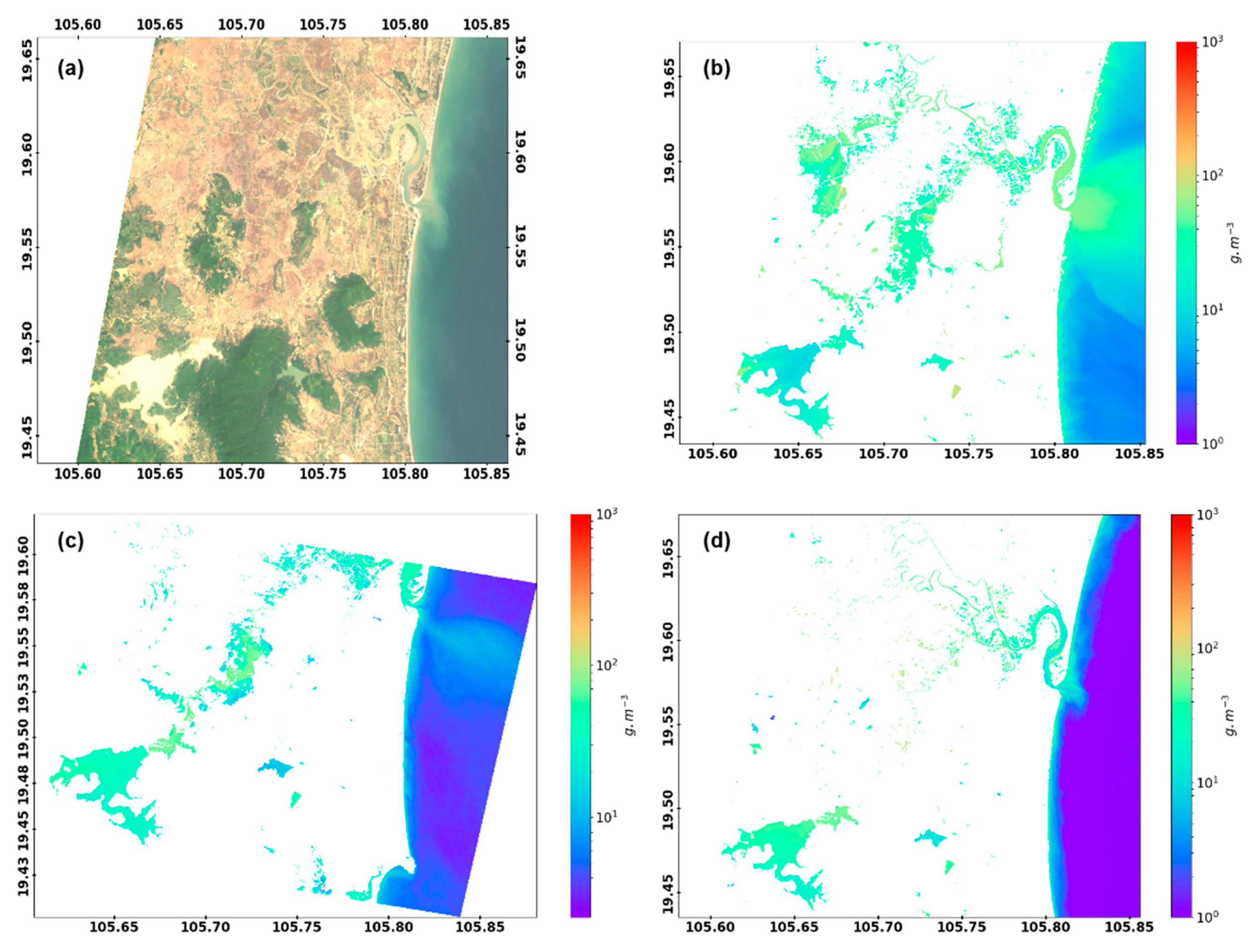
| Band | Wavelength (nm) | Resolution (m) | Gain | Bias |
|---|---|---|---|---|
| B1–Blue | 450–520 | 10 | 1.638 | 0 |
| B2–Green | 530–600 | 10 | 1.621 | 0 |
| B3–Red | 620–690 | 10 | 1.848 | 0 |
| B4–Near Infrared | 760–890 | 10 | 2.511 | 0 |
| B5–Panchromatic | 450–740 | 2.5 | 1.950 | 0 |
| Data Set | N | Min, Max | Geometric Mean | Standard Deviation |
|---|---|---|---|---|
| Development (D-DS) | 143 | 0.47, 188.12 | 5.44 | 27.51 |
| Validation (V-DS) | 62 | 0.52, 240.14 | 6.84 | 42.77 |
| Overall | 205 | 0.47, 240.14 | 5.68 | 32.85 |
| Data Set | N | Min, Max | Geometric Mean | Standard Deviation |
|---|---|---|---|---|
| Tonlesap, Cambodia(13 October 2018) | 18 | 3.33, 15.25 | 5.85 | 3.00 |
| Cuaviet estuary, Vietnam(25 April 2019) | 20 | 8.30, 14.90 | 10.20 | 1.60 |
| Han estuary, Vietnam(4 May 2019) | 13 | 6.84, 14.58 | 10.54 | 2.37 |
| Overall | 51 | 3.33, 15.25 | 8.45 | 3.07 |
| Algorithm | MAPD (%) | RMSDlog | Slope | Bias | R2 |
|---|---|---|---|---|---|
| Doxaran | 218 | 0.725 | 0.258 | 1.200 | 0.54 |
| Nechad | 36 | 0.255 | 0.670 | 0.304 | 0.86 |
| Siswanto | 46 | 0.45 | 0.831 | −0.203 | 0.78 |
| Bing Han | 30 | 0.321 | 0.848 | −0.064 | 0.81 |
| V1SPM | 18 | 0.188 | 0.877 | 0.058 | 0.91 |
| Data Set | MAPD (%) | RMSDlog | Slope | Bias | R2 |
|---|---|---|---|---|---|
| Tonle Sap | 15.87 | 0.13 | 0.979 | 0.515 | 0.793 |
| Cuaviet | 17.33 | 0.09 | 0.243 | 8.987 | 0.068 |
| Han | 13.86 | 0.08 | 0.931 | −0.265 | 0.734 |
| All | 15.79 | 0.10 | 0.875 | 1.431 | 0.703 |
© 2020 by the authors. Licensee MDPI, Basel, Switzerland. This article is an open access article distributed under the terms and conditions of the Creative Commons Attribution (CC BY) license (http://creativecommons.org/licenses/by/4.0/).
Share and Cite
Ngoc, D.D.; Loisel, H.; Vantrepotte, V.; Chu Xuan, H.; Nguyen Minh, N.; Verpoorter, C.; Meriaux, X.; Pham Thi Minh, H.; Le Thi, H.; Le Vu Hong, H.; et al. A Simple Empirical Band-Ratio Algorithm to Assess Suspended Particulate Matter from Remote Sensing over Coastal and Inland Waters of Vietnam: Application to the VNREDSat-1/NAOMI Sensor. Water 2020, 12, 2636. https://doi.org/10.3390/w12092636
Ngoc DD, Loisel H, Vantrepotte V, Chu Xuan H, Nguyen Minh N, Verpoorter C, Meriaux X, Pham Thi Minh H, Le Thi H, Le Vu Hong H, et al. A Simple Empirical Band-Ratio Algorithm to Assess Suspended Particulate Matter from Remote Sensing over Coastal and Inland Waters of Vietnam: Application to the VNREDSat-1/NAOMI Sensor. Water. 2020; 12(9):2636. https://doi.org/10.3390/w12092636
Chicago/Turabian StyleNgoc, Dat Dinh, Hubert Loisel, Vincent Vantrepotte, Huy Chu Xuan, Ngoc Nguyen Minh, Charles Verpoorter, Xavier Meriaux, Hanh Pham Thi Minh, Huong Le Thi, Hai Le Vu Hong, and et al. 2020. "A Simple Empirical Band-Ratio Algorithm to Assess Suspended Particulate Matter from Remote Sensing over Coastal and Inland Waters of Vietnam: Application to the VNREDSat-1/NAOMI Sensor" Water 12, no. 9: 2636. https://doi.org/10.3390/w12092636
APA StyleNgoc, D. D., Loisel, H., Vantrepotte, V., Chu Xuan, H., Nguyen Minh, N., Verpoorter, C., Meriaux, X., Pham Thi Minh, H., Le Thi, H., Le Vu Hong, H., & Nguyen Van, T. (2020). A Simple Empirical Band-Ratio Algorithm to Assess Suspended Particulate Matter from Remote Sensing over Coastal and Inland Waters of Vietnam: Application to the VNREDSat-1/NAOMI Sensor. Water, 12(9), 2636. https://doi.org/10.3390/w12092636






